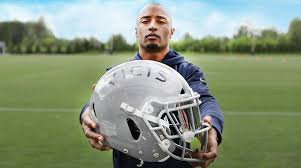March 2, 2025
In a groundbreaking step towards player safety, the NFL has announced the introduction of a new helmet technology designed to significantly reduce the risk of concussions and head injuries during the 2025 season. The helmet, developed in partnership with leading engineering firms and medical experts, integrates advanced materials and sensors aimed at detecting and mitigating the impact of collisions on players’ heads.
This new initiative, called SafeHead, is the latest in a series of moves by the NFL to prioritize player safety and protect athletes from the long-term effects of head injuries, which have been a major concern in professional football. The new helmet will be worn by all NFL players beginning in the 2025 season, marking a significant milestone in the league’s ongoing efforts to address concussion-related issues.
“We are committed to the health and well-being of our players, and the introduction of SafeHead represents the next frontier in player safety,” said NFL Commissioner Roger Goodell. “This technology is designed to prevent injuries before they happen, ensuring that our athletes can continue to perform at the highest level while minimizing the long-term risks associated with head trauma.”
SafeHead helmets feature a combination of advanced cushioning materials, such as a lightweight, impact-absorbing foam, and embedded sensors that measure the force and direction of impacts during games. The sensors in the helmets will provide real-time data to medical staff on the field, giving them instant feedback on the severity of any hit to a player’s head. If a potentially dangerous impact is detected, the system will automatically alert team doctors and coaches to assess the player for a concussion, even before the athlete may show symptoms.
In addition to improving player safety, the SafeHead technology is expected to assist in the league’s broader efforts to reduce the overall number of concussions in professional football. Over the past decade, the NFL has faced increasing scrutiny over its handling of head injuries, especially as studies have shown a link between repeated concussions and chronic traumatic encephalopathy (CTE), a degenerative brain disease found in many former players.
The NFL has been under pressure to find effective solutions to combat these risks, and SafeHead is seen as a major step forward. The helmet’s ability to detect high-risk impacts in real-time could drastically reduce the number of concussions during games and provide a more proactive approach to injury management.
Players’ reactions to the new helmet have been mostly positive, with many expressing optimism about the enhanced protection it offers. “We’ve come a long way with helmet technology,” said quarterback Patrick Mahomes. “As players, we know that the game can be dangerous, and the SafeHead helmet gives us peace of mind knowing that we’re doing everything possible to protect ourselves while we play the sport we love.”
While the SafeHead helmet is not expected to eliminate all head injuries in football, experts believe that it represents a crucial development in making the sport safer for players of all ages. In addition to the new helmets, the NFL is also continuing its efforts to reduce the amount of full-contact practice during training camps, as well as implementing stricter rules around helmet-to-helmet collisions during games.
The NFL is already in talks with other sports leagues to share the technology, with discussions about potentially introducing SafeHead helmets to college football and other professional sports leagues underway.
As the 2025 season approaches, the NFL’s introduction of this groundbreaking helmet technology is expected to be one of the most significant advancements in player safety in the league’s history. With SafeHead, the NFL is not only improving the immediate protection of its athletes but also setting a new standard for how professional sports leagues approach concussion prevention, ultimately aiming to make the game safer for generations to come.
